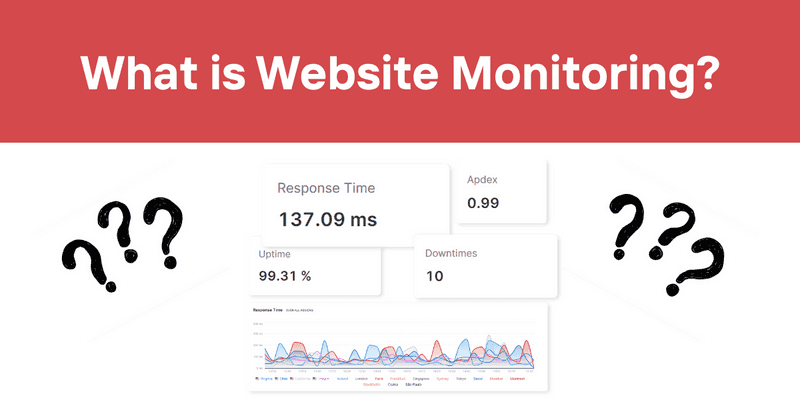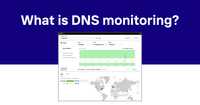What is Website Monitoring?
Downtime isn’t just an inconvenience, it’s a critical business risk. Imagine losing customers, revenue, and reputation in the blink of an eye, just because your site wasn't accessible. There are also security risks to consider.
The good news, though, is that website monitoring can help you enjoy peace of mind knowing your site is up and running at all times. What is website monitoring, though? And how can you invest in it to ensure your online presence is robust, reliable, and consistently delivering value to your users?
At Odown, we understand the heartbeat of your online business isn't just about being 'live'. It's about ensuring seamless performance, ironclad security, and an uninterrupted user experience.
Our unique suite encompasses website monitoring, SSL monitoring, status page, and incident management It’s tailored specifically for the discerning DevOps professional and the strategic CTO.
You’re safeguarding your digital asset with Odown’s website uptime monitoring solution. That being said, let’s start with the basics: what is website monitoring?
What is Website Monitoring?
At its core, website monitoring is a comprehensive process that involves continuously checking and verifying that a website is available, functional, and performing as expected.
It's a crucial aspect of managing any online presence, whether it's a simple blog or a complex e-commerce platform. In an age where the internet never sleeps, website monitoring ensures that your digital doorstep is always open, welcoming, and efficient.
The essence of website monitoring lies in its ability to provide real-time feedback and alerts on the status of a website. It acts as an early warning system, identifying issues as soon as they arise, which allows for swift action to rectify any problems.
There are a number of different ways you can monitor your website - on-premise or through the cloud, synthetically or with real users, etc. We’ll cover all this later on. First, we need to talk about why website monitoring matters.
Why is Website Monitoring Important?
What is website monitoring so important for? Your website is often the first interaction a potential customer has with your business. It's a powerful tool for building credibility, generating revenue, and providing services.
This is where the importance of website monitoring becomes evident. Let's break down why it's crucial for any business with an online presence. Then, we’ll help you gain a better understanding of how it works and how you can reap its benefits yourself.
-
Non-Stop Operation: Website monitoring ensures that your site is always available to visitors, regardless of their time zone or geography. This continuous operation is crucial for businesses that cater to a global audience or operate in e-commerce, where any downtime directly translates to lost sales or a bad user experience that could harm your reputation.
-
Performance Optimization: This means faster loading times, efficient navigation, and quick access to information. Monitoring tools can identify performance bottlenecks, such as slow-loading pages or server overload, allowing for immediate rectification.
-
SEO Advantages: With better performance comes better organic rankings. Search engines favor websites that are reliable and fast. Consistent uptime and quick loading times, ensured by effective website monitoring, can improve your site's search engine rankings, making it more visible and accessible to potential customers.
-
Proactive Issue Resolution: Website monitoring enables businesses to be proactive rather than reactive. You can scan for, identify, and resolve issues before they escalate into larger problems that impact users. This proactive approach saves time, resources, and potential lost revenue.
-
Scalability Insights: Monitoring provides valuable data on how well your site handles increased loads and what improvements are needed to support growth. This insight is invaluable for planning and scaling your website infrastructure effectively. You also gain a wealth of data about user behavior, site performance, and potential issues. This data is crucial for making informed decisions about website improvements, marketing strategies, and user engagement tactics.
Understanding the Scope of Website Monitoring
Website monitoring encompasses a broad range of activities, each aimed at ensuring your website delivers the best possible experience to its users.
Monitoring Website Uptime and Downtime
Uptime is the measure of how long your website is accessible and operational, is a critical metric in website monitoring. High uptime percentages are indicative of a reliable and robust website, which is essential for maintaining customer trust and satisfaction.
Monitoring isn't just about knowing when your site is down, though. It's about understanding why. You can implement targeted solutions to prevent future occurrences by analyzing downtime causes, whether they're server issues, network problems, or coding errors.
Uptime monitoring also involves verifying that your website is accessible from various geographic locations. This ensures that customers worldwide receive a consistent experience, crucial for global businesses.
Instant notification systems are integral to uptime monitoring, enabling swift responses to any downtime incidents, minimizing the duration and impact of website outages.
Performance Monitoring: Speed and Response Times
It’s not just a matter of making sure your website works - it needs to be working well. There’s a lot that goes into monitoring performance, but speed is paramount.
A website's load time is a key factor in user satisfaction and search engine ranking. Performance monitoring tools assess the time it takes for pages to load, helping identify elements that may be causing delays.
Response times matter too, though. User interaction with your website should be smooth and immediate. Monitoring the response times of different elements, from image loading to script execution, ensures a seamless user experience.
You can pinpoint bottlenecks in your website's infrastructure or code, allowing for precise optimization efforts by tracking performance metrics. Regularly benchmarking your website's performance against industry standards and competitors helps you understand where you stand and what improvements are needed.
Security Monitoring: SSL Certificates and Vulnerability Scans
Secure Socket Layer (SSL) certificates are crucial for establishing a secure connection between a website and its users. SSL monitoring ensures certificates are up-to-date, valid, and haven't been compromised, maintaining the integrity of data transmissions.
Regular scanning for vulnerabilities in your website’s code and infrastructure helps in the early detection of potential security threats, safeguarding against data breaches and cyber-attacks.
There’s also the consideration of compliance for websites handling sensitive user data. Your website must adhere to security standards like GDPR, PCI DSS. This protects both user data and your business from legal repercussions.
A secure website fosters trust among users. You reassure visitors of your commitment to protecting their data by actively monitoring and addressing security concerns, enhancing your website's credibility.
Different Types of Website Monitoring
Website monitoring is not a one-size-fits-all solution. There are different types of monitoring, each suited to specific needs and objectives.
Understanding these variations helps in selecting the right approach for your website's unique requirements, ensuring effective and comprehensive monitoring. We’ll guide you through choosing the right one after fully explaining the different options.
Synthetic Monitoring vs Real User Monitoring
Synthetic monitoring, also known as proactive monitoring, involves simulating user interactions with your website using automated scripts. This method tests the website's performance in a controlled environment.
It provides insights into how your site performs under different conditions, such as increased traffic or server maintenance, helping predict potential issues before they impact real users.
Unlike real users, synthetic monitoring operates continuously, providing constant checks on your website's availability, functionality, and performance.
On the other hand, real user monitoring (RUM) tracks the experiences of actual users interacting with your website. It captures live data on how your site performs in real-world scenarios.
This type of monitoring provides valuable insights into how users interact with your website, including load times, navigation paths, and user engagement.
RUM data is instrumental in identifying specific areas for improvement, tailored to enhance the actual user experience.
On-Premise vs Cloud-Based Solutions
On-premise solutions involve hosting the monitoring tools on your own servers. This approach offers complete control over the monitoring process and data.
As such, they can be highly customized and integrated deeply with your internal systems, offering tailored monitoring solutions. However, they can be resource-intensive in terms of setup, maintenance, and updates, requiring dedicated IT staff and infrastructure.
Cloud-based monitoring solutions are hosted on the provider’s servers, offering greater flexibility and scalability. They are ideal for businesses looking for quick deployment and minimal maintenance.
These solutions often operate on a subscription model, making them more cost-effective, especially for small to medium-sized businesses. They are accessible from anywhere, too. This type of monitoring also ensures you always have access to the latest features and security updates.
How to Invest in Website Monitoring For Your Company to Enjoy Peace of Mind
Investing in website monitoring is a strategic decision that can significantly enhance your business's online presence and reliability. We'll guide you through a comprehensive approach to getting started with website monitoring, ensuring you reap maximum benefits from your investment.
Evaluating Your Website's Specific Needs
Start by assessing the complexity of your website. Does it have e-commerce capabilities, integrations with other services, or dynamic content? The more complex your site, the more sophisticated your monitoring needs might be.
You should also take a moment to analyze your website's traffic. High-traffic sites require more robust monitoring solutions to handle the load and detect issues quickly.
Before you start searching for a solution, determine what KPIs are most critical for your website. This could include uptime, page load speed, or the performance of specific functionalities.
Choosing the Right Monitoring Tool for Your Business
Now comes the hard part - choosing the right monitoring solution for your business. Decide between synthetic monitoring for predictive insights and real user monitoring for actual user experience data. In many cases, a combination of both offers a comprehensive overview.
You’ll also need to choose between cloud-based vs on-premise monitoring. Cloud-based solutions often offer greater flexibility and lower upfront costs. This is typically going to be your best bet.
Look for solutions that offer the features you need now, but also have the scalability to grow with your business as you peruse your options. You don’t want to be short-sighted in choosing a solution and end up having to rethink things just a few weeks or months down the road.
As we said at the start, Odown is your trusted choice for effortless, real-time website monitoring. We’ll talk more about why that is later on.
Setting Up and Configuring Your Monitoring
Work with your IT team or the monitoring service provider to set up the monitoring tools on your website. This might involve installing software or integrating with APIs. We make this process seamless here at Odown.
Customize the alerts and thresholds according to your needs. Decide who in your team receives alerts and for what types of incidents.
You can play around a bit initially and test different settings or configurations to fine-tune the monitoring system. This phase is crucial for ensuring that the monitoring setup aligns with your expectations.
Leveraging Monitoring Data for Improvement
While most of the hard work of monitoring your website is done by this point, it’s now up to you to stay up to date and regularly review the data and reports generated by your monitoring tools. Look for trends or recurring issues that need attention.
Use the insights gained from monitoring data to make informed decisions on website improvements, infrastructure upgrades, or content optimization.
Get Started For Free Today With Odown’s Website Uptime Monitoring Solution!
Now that you know all about the importance of uptime monitoring and how you can use it to your advantage, there’s only one thing left to do: get started with Odown today!
Our advanced monitoring technology offers real-time, comprehensive insights into your site's performance, ensuring maximum availability and minimal downtime.
With our user-friendly dashboard, instant alert system, and detailed analytics, you're empowered to make informed decisions swiftly.
Our unique blend of affordability, versatility, and top-tier customer support sets us apart, making Odown an ideal partner for businesses aiming to maintain an impeccable online presence.
Still not sure we’re the right solution? See what makes us the #1 Pingdom alternative, Statuscake alternative, Statuspage alternative, or Uptimerobot alternative in our detailed comparisons as we bring this guide on website monitoring to a close.
Bringing Our Beginner’s Guide on Website Monitoring to a Close
So, what is website monitoring? It’s so much more than a measure for preventing downtime, although that is a factor. Uptime monitoring is about ensuring optimal performance, security, and user satisfaction.
We hope this conversation has left you with clarity on the role it plays in running your website, the different types of monitoring solutions you can choose from, and how to implement the right one.
Don't let website issues hinder your success. Discover the peace of mind that comes with Odown by learning more about our website monitoring software today!



